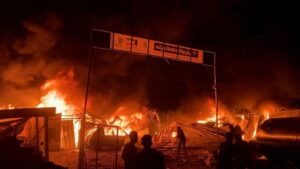South Korea sets nationwide civil defense drill, citing North’s ‘provocations’


Seoul, South Korea
CNN
—
As tensions with North Korea spike, South Korea will hold its first nationwide civil defense drill in six years later this month, requiring most of the country’s 51 million residents to practice evacuating to shelters or underground safe spaces during the 20-minute exercise.
The drill, scheduled for 2 p.m. on Wednesday, August 23, will see many drivers required to pull over to the side of roads and the exits to subway stations closed with commuters required to remain inside, a statement from the South Korean Interior Ministry said.
“We expect to strengthen the response capacity of the nation through a practical drill reflecting the aspects of provocations of North Korea,” Prime Minister Han Duck-soo said in a news release this week.
The release said the 20-minute drill is part of a larger exercise to test the South Korean government’s response to potential threats including “advanced nuclear missile threats, cyber attacks, drone terrors, etc.”
The prime minister also called on South Koreans to take the drills seriously, something that hasn’t always been the case.
Many South Koreans have become resigned to the fact that much of the population would only have minutes to respond to any possible North Korean missile or airstrike.
The capital Seoul, for example, lies just 30 miles south of the demilitarized zone that separates the South from the North, which maintains a vast array of artillery along its border.
But Han said citizens should “follow the lead of the nation during the exercise and actively participate in it.”
Instructions from the Interior Ministry said 17,000 shelters would be open nationwide, and locations are searchable in popular Korean apps.
To minimize disruption to key services, the ministry said hospitals, airlines, railways, subways and commercial sea traffic would not be affected by the emergency drill.
It also said 13 areas of the country designated as a disaster zone following recent heavy rainfall would be excluded from the drill.
South Koreans have long become used to periods of fractious relations with the North, but the current level of tensions are especially high.
North Korea last month launched an intercontinental ballistic missile with its longest flight time ever, the latest advancement in a missile program that has been testing at a breakneck pace over the past two years under leader Kim Jong Un.
The launch of the Hwasong-18 missile was conducted “at a grave period when the military security situation on the Korean Peninsula and in the region has reached the phase of nuclear crisis beyond the Cold War,” a statement in North Korean state media said.
Later in July, a US Navy nuclear-capable ballistic missile submarine called in the South Korean port of Busan, prompting more threats from Pyongyang, with North Korean Defense Minister Kang Sun Nam saying the presence of the vessel may meet the country’s criteria for use of nuclear weapons.
Pyongyang tested short-range ballistic missiles after the US sub made its call in Busan.
Han, the South Korean prime minister, said the civil defense drill would be held in conjunction with large-scale US-South Korea military exercises that have drawn sharp criticism from Pyongyang in the past.
It will also come less than a week after South Korean President Yoon Suk Yeol travels to the United States for a trilateral meeting with US President Joe Biden and Japanese Prime Minister Fumio Kishida, where “the continued threat posed by” North Korea will be on the agenda, according to a White House statement.








